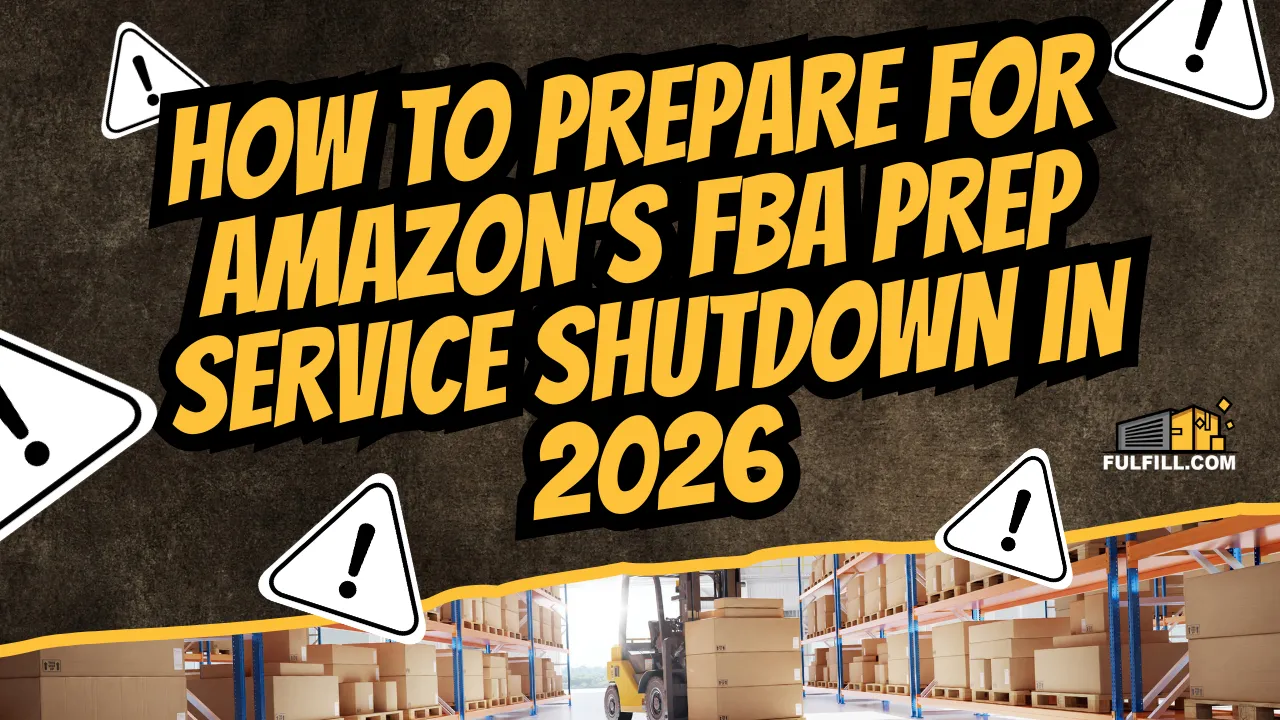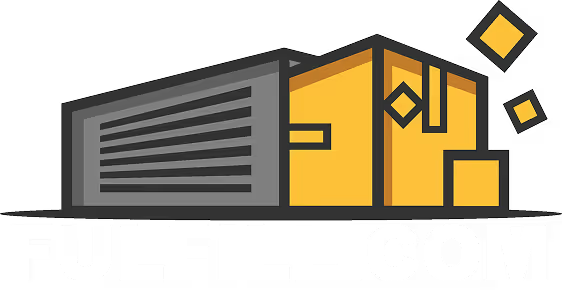Quick Jump
Amazon's announcement to discontinue FBA prep and labeling services by January 1, 2026, marks a seismic shift in eCommerce fulfillment. This comprehensive guide examines the full impact on sellers, opportunities for 3PLs, and strategic preparation steps for this major operational change.
Breaking News: The End of an Era for FBA Prep
Starting January 1, 2026, prep and item labeling services for Fulfillment by Amazon (FBA) shipments will no longer be available in the US marketplace. This sweeping change affects millions of Amazon sellers who have relied on Amazon's in-house prep services for everything from bubble wrapping and poly-bagging to FNSKU labeling and bundling.
The announcement, made on July 28, 2025, gives sellers approximately five months to completely restructure their fulfillment operations. "The vast majority of Amazon sellers now handle their own packaging, including prep and item labeling, either on their own, through their own manufacturing partners or through third-party service providers which allows FBA to focus on providing faster and more efficient fulfillment center operations," Amazon stated in their official notification.
What's Actually Ending?
The scope of this change is comprehensive. Amazon will discontinue:
- FNSKU barcode labeling - No more Amazon-applied product labels
- Poly bagging - Clear plastic bag protection for textiles and other items
- Bubble wrapping - Protective packaging for fragile items
- Taping - Securing loose parts or packaging
- Opaque bagging - For adult products or items requiring privacy
- Suffocation warning labels - Required safety labels for plastic bags
- Bundle creation - Multi-pack assembly services
- Set preparation - Organizing multi-piece products
- Item inspection - Quality control checks
- Sticker removal - Eliminating old barcodes or pricing
This shift affects all inventory shipped directly to Fulfillment by Amazon (FBA) centers, as well as those funneled through Amazon Warehousing and Distribution (AWD) or Amazon Global Logistics (AGL).
The Timeline You Need to Know
Understanding the precise timeline is critical for planning your transition:
Now through December 31, 2025:
- Amazon prep services continue operating as normal
- Sellers can still select Amazon as the prep provider
- All current pricing remains in effect
- This is your transition period - use it wisely
January 1, 2026 and beyond:
- All new shipments must arrive fully prepped and labeled
- Shipments created before Jan 1 will still be serviced, even if they arrive in early 2026
- Products arriving unprepped will face rejection or disposal
- No reimbursement for lost or damaged unprepped items
Why Is Amazon Making This Change?
Amazon's decision reflects several strategic considerations:
- Operational Efficiency: Prep and labeling are labor-intensive processes that slow down inventory movement. Removing these services allows Amazon to accelerate throughput and reduce bottlenecks, especially during peak seasons like Q4.
- Automation Push: Amazon's fulfillment centers are increasingly automated. Manual services like labeling and poly bagging are incompatible with the company's push for scalable, robotics-driven fulfillment.
- Market Evolution: Amazon notes that seller capabilities have matured significantly, with most already handling their own prep through various means.
- Cost Reduction: While not explicitly stated, eliminating these labor-intensive services likely reduces Amazon's operational costs significantly.
What This Means for eCommerce Brands
The impact on Amazon sellers varies dramatically based on their current operations, size, and product complexity. Here's a comprehensive breakdown of what brands need to consider:
Immediate Operational Impact
For Sellers Currently Using Amazon Prep:
- Must find alternative prep solutions within 5 months
- Face immediate cost structure changes
- Need to audit entire product catalog for prep requirements
- Risk supply chain disruptions during transition
Cost Implications: The financial impact extends beyond simple prep fees:
- New Direct Costs: Materials (poly bags, labels, bubble wrap) plus labor or 3PL fees
- Hidden Costs: Training, quality control, rejected shipment risks
- Opportunity Costs: Time spent managing prep instead of growing business
- Potential Savings: Many sellers report 15-30% cost savings when switching to efficient 3PL partners
Small vs. Large Seller Impacts
Small Sellers (Under 500 orders/month):
- Most vulnerable to this change
- Often lack resources for in-house prep
- May face proportionally higher costs
- Could be forced to significantly restructure operations
Medium Sellers (500-5,000 orders/month):
- Have more options but face scaling challenges
- May benefit from 3PL volume discounts
- Need to balance cost vs. control
Large Sellers (5,000+ orders/month):
- Many already use 3PLs or in-house prep
- Can negotiate better rates with prep providers
- Have resources to adapt quickly
Risk Factors to Consider
If the prep work isn't up to their standards, Amazon might reject your inventory, charge you disposal fees, or delay your products during busy selling seasons. Additional risks include:
- Compliance Failures: One wrong label or missing poly bag can result in entire shipment rejection
- Seasonal Vulnerabilities: Q4 2025 timing creates massive risk for holiday sellers
- Cash Flow Impact: Upfront investment in prep materials or 3PL deposits
- Quality Control: Loss of Amazon's standardized prep quality
Strategic Opportunities
While challenging, this change also creates opportunities:
- Cost Optimization: While Amazon's prep services were convenient, they weren't always the cheapest option. This change forces you to look at your real costs and maybe find better alternatives.
- Quality Control: Direct oversight of prep processes
- Flexibility: Custom packaging and branding opportunities
- Speed: Potential for faster processing with dedicated partners
- Multi-Channel Efficiency: Consolidated prep for Amazon and other channels
What This Means for 3PLs: A Golden Opportunity
This move creates a massive opportunity within the third-party logistics (3PL) sector, a market projected to reach $1.87 trillion by 2030. For 3PL providers, this represents perhaps the single largest market opportunity in recent years.
Market Size and Opportunity
Consider the scale:
- 1.1 million active Amazon marketplace sellers in the US
- Estimated 200,000-300,000 sellers currently using Amazon prep services
- Average prep cost of $0.50-2.00 per unit
- Billions of units requiring prep annually
"The real winner from this will be 3PLs. As millions of sellers go hunting for these services, these companies will print cash."
3PL Preparation Strategies
Smart 3PLs are already positioning themselves:
- Capacity Expansion: Leading providers like MyFBAPrep report 85M square feet of operating space to prep items for Amazon spread across the USA
- Amazon Partnerships: MyFBAPrep was selected by Amazon as a Recommended Prep Service Provider for Fulfillment by Amazon (FBA), following Amazon's most extensive national vetting process to date.
- Technology Investment: Automated systems for labeling, quality control, and inventory management
- Geographic Expansion: Strategic warehouse placement near Amazon fulfillment centers
- Service Differentiation: Specialized offerings for complex prep requirements
Competitive Advantages for 3PLs
The 3PLs best positioned to capture this opportunity share several characteristics:
- Proven Amazon Expertise: Deep understanding of FBA requirements
- Scalable Infrastructure: Ability to handle surge in demand
- Technology Integration: Direct connections to Amazon's systems
- Transparent Pricing: Clear, competitive fee structures
- Geographic Coverage: Multiple locations for efficient shipping
- Specialized Services: Capabilities for regulated products, kitting, bundling
Pricing Opportunities
3PLs have flexibility in pricing strategies:
- Volume Discounts: Attracting larger sellers with scaled pricing
- Value-Added Services: Premium offerings for complex prep needs
- Speed Premiums: Rush processing for time-sensitive inventory
- All-Inclusive Packages: Bundled storage, prep, and shipping
Strategic Preparation: Your Action Plan
Success requires immediate action and careful planning. Here's your comprehensive preparation roadmap:
Phase 1: Immediate Assessment (August 2025)
Week 1-2: Audit Current Operations
- Identify all SKUs using Amazon prep services
- Calculate current prep costs per SKU
- Document specific prep requirements for each product
- Assess seasonal inventory needs
Week 3-4: Research Solutions
- Request quotes from 5-7 potential 3PL partners
- Evaluate in-house prep feasibility
- Consider hybrid approaches
- Review technology requirements
Phase 2: Testing and Selection (September-October 2025)
Testing Protocol:
- Send test shipments to top 3 provider candidates
- Evaluate turnaround time, quality, communication
- Verify Amazon compliance rates
- Test peak capacity capabilities
Selection Criteria:
- Amazon expertise and compliance history
- Geographic proximity to your suppliers/customers
- Technology integration capabilities
- Scalability for growth
- Transparent pricing with no hidden fees
- References from similar businesses
Phase 3: Implementation (November 2025)
Transition Strategy:
- Start with low-risk, low-volume SKUs
- Gradually migrate high-volume products
- Maintain backup options for critical items
- Document all processes and requirements
Phase 4: Optimization (December 2025 and beyond)
Continuous Improvement:
- Monitor rejection rates and compliance
- Optimize for cost and speed
- Develop contingency plans
- Build strategic partnerships
Alternative Solutions and Options
Beyond traditional 3PL partnerships, sellers have several strategic options:
1. In-House Prep Operations
Pros:
- Complete control over quality
- Potential cost savings at scale
- Flexibility in processes
Cons:
- Significant upfront investment
- Labor management challenges
- Compliance responsibility
- Space requirements
Best For: Large sellers with consistent volume and existing warehouse operations
2. Hybrid Models
Combine multiple approaches:
- In-house prep for simple items
- 3PL for complex or regulated products
- Manufacturer prep for private label
- Regional solutions for different product lines
3. Ships in Product Packaging (SIPP)
To help reduce your supply chain costs, you can use Ships in Product Packaging for FBA (SIPP) for eligible products, as it can lower prep needs and provide FBA discounts.
Benefits:
- Eliminate prep requirements entirely
- Reduce packaging waste
- Potentially lower costs
- Faster processing
Requirements:
- Products must be secure in original packaging
- Meet Amazon's certification requirements
- Not suitable for all product types
4. Manufacturer Integration
Work directly with suppliers to:
- Apply FNSKU labels at point of manufacture
- Implement Amazon-compliant packaging
- Reduce touches in supply chain
- Lower overall costs
Technology and Systems Considerations
The end of Amazon prep services makes technology more critical than ever:
Essential Technology Features
- Inventory Management Systems
- Real-time visibility across locations
- Prep requirement tracking
- Compliance monitoring
- Cost analysis by SKU
- Integration Requirements
- Direct Amazon Seller Central connection
- Automated shipment creation
- Label printing capabilities
- Error prevention systems
- Quality Control Systems
- Photo documentation
- Compliance checklists
- Rejection tracking
- Performance analytics
Recommended Software Solutions
Leading 3PLs offer proprietary systems:
- Real-time inventory tracking
- Automated compliance checking
- Direct Amazon integration
- Mobile accessibility
- Detailed reporting
Financial Impact Analysis
Understanding the true financial impact requires comprehensive analysis:
Cost Comparison Framework
Previous Amazon Prep Costs:
- Label application: $0.30-0.55 per unit
- Poly bagging: $0.70-1.25 per unit
- Bubble wrap: $1.00-1.80 per unit
- Bundle creation: $1.00-2.00 per bundle
Typical 3PL Pricing:
- Basic prep: $0.25-0.50 per unit
- Complex prep: $0.75-1.50 per unit
- Volume discounts: 10-30% for high volume
- Additional services: Varies by complexity
Hidden Cost Considerations
Factor in all costs:
- Transition expenses
- Training and systems
- Potential errors and rejections
- Opportunity costs
- Cash flow impacts
ROI Calculation
Many sellers find positive ROI through:
- Lower per-unit costs with efficient 3PLs
- Reduced rejection rates
- Faster processing times
- Multi-channel efficiencies
- Improved quality control
Industry Expert Perspectives
"This is one of the most significant operational shifts Amazon has made in recent years," notes Charles Williams, senior manager of marketplace operations at Blue Wheel.
The consensus among industry experts:
- This change was inevitable given Amazon's automation trajectory
- Well-prepared sellers will gain competitive advantages
- 3PLs with Amazon expertise will see explosive growth
- Market consolidation likely as demand surges
Looking Ahead: The Future of FBA Fulfillment
This change signals broader shifts in Amazon's strategy:
Predicted Future Changes
- Further Automation Requirements: Expect more standardization in packaging and labeling
- Increased Seller Responsibility: Amazon continuing to shift operational burden to sellers
- Technology Mandates: Potential requirements for automated data exchange
- Quality Standards: Stricter compliance and penalty structures
Long-Term Strategic Considerations
Successful sellers will:
- Build flexible, scalable prep operations
- Invest in technology and automation
- Develop multiple fulfillment channels
- Create contingency plans for disruptions
- Focus on efficiency and quality
Conclusion: Turning Challenge into Opportunity
While Amazon's decision to end FBA prep services presents immediate challenges, it also creates opportunities for sellers willing to adapt strategically. The keys to success:
- Act Now: Don't wait until December to start planning
- Choose Partners Wisely: Vet 3PLs thoroughly for Amazon expertise
- Test Everything: Validate solutions before full commitment
- Plan for Growth: Select scalable solutions
- Monitor and Optimize: Continuously improve processes
The sellers who thrive through this transition will be those who view it not as an obstacle, but as an opportunity to optimize their operations, reduce costs, and gain greater control over their fulfillment processes.
For 3PLs, this represents a generational opportunity to capture market share and build lasting partnerships with Amazon sellers. Those who can demonstrate expertise, reliability, and value will position themselves as essential partners in the new FBA ecosystem.
The countdown to January 1, 2026, has begun. The question isn't whether you'll adapt – it's how quickly and effectively you'll transform this challenge into your competitive advantage.
Need help preparing for the end of Amazon FBA prep services? Contact our recommended 3PL partners or use our free matching service to find the perfect prep solution for your business.










